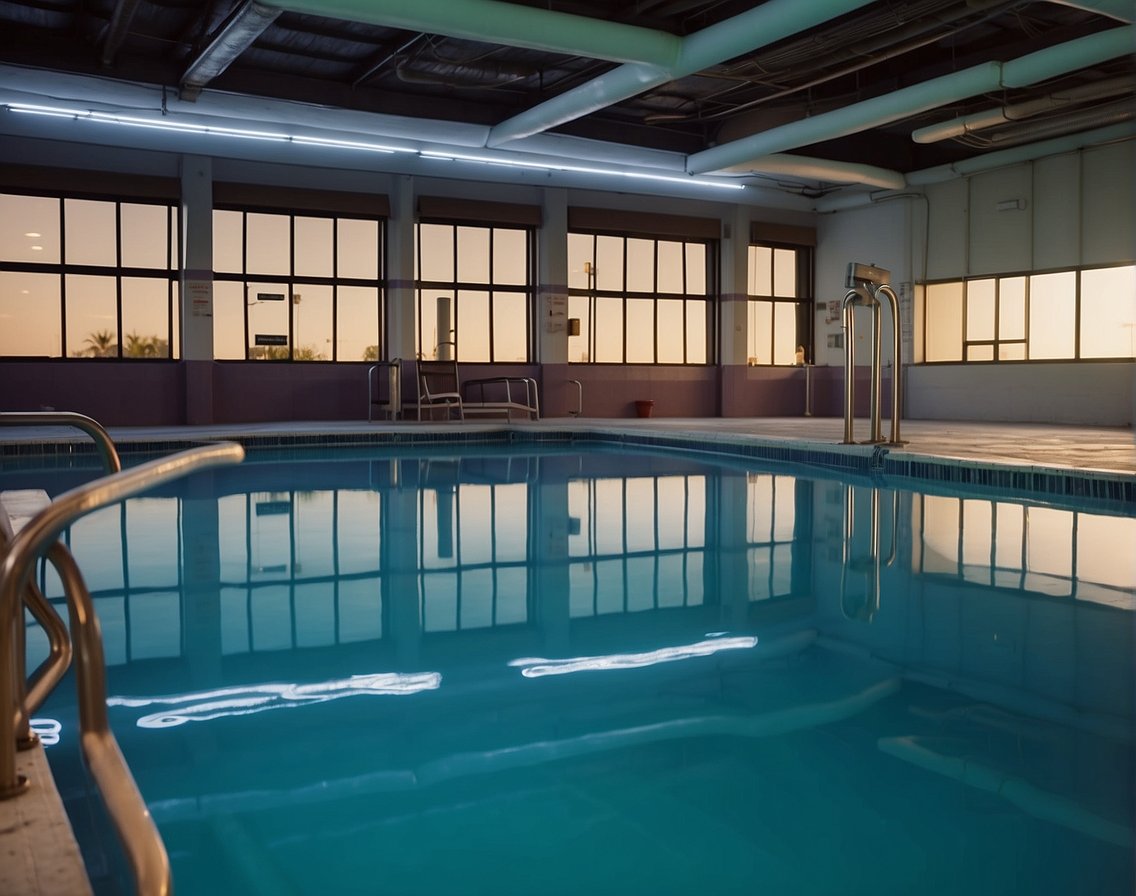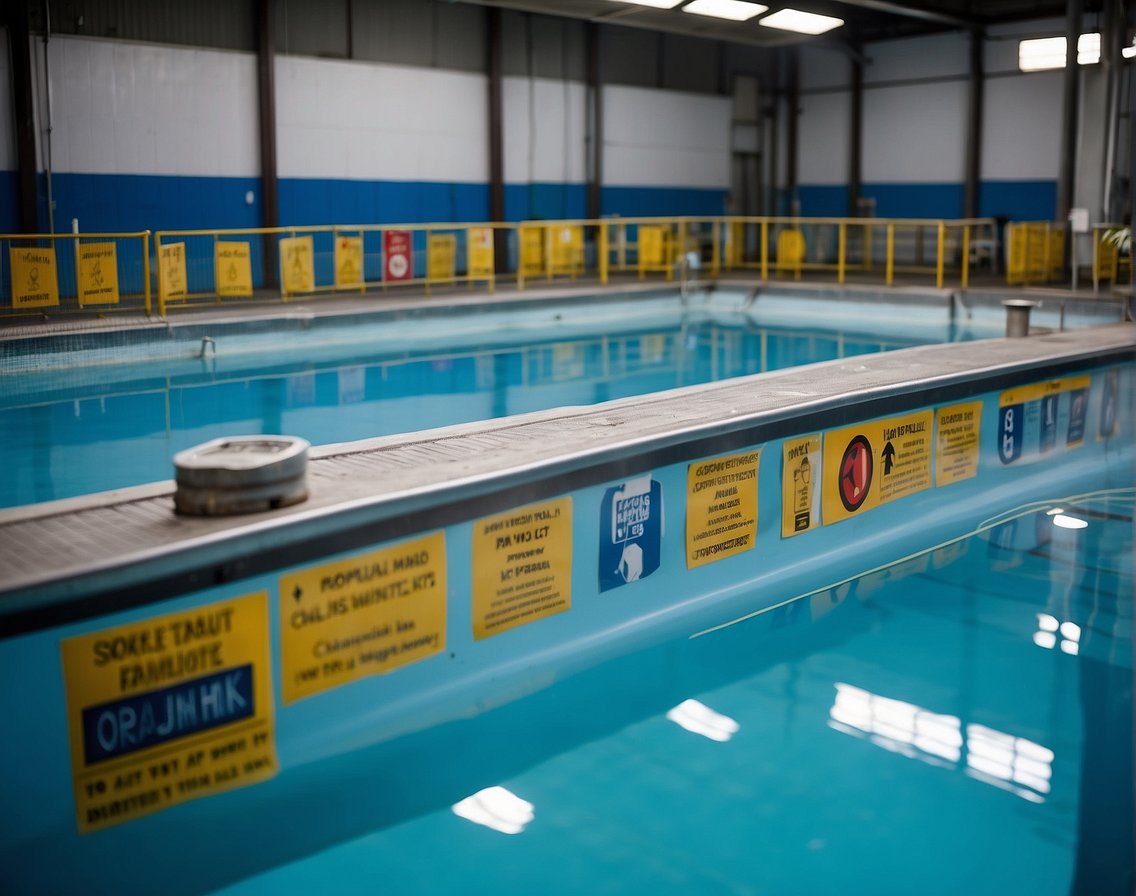Understanding Pool Water Chemistry

Maintaining the appropriate chemical balance in pool water is essential for the safety and comfort of swimmers, as well as the longevity of the pool’s physical components. We’ll focus on the key aspects of water chemistry to ensure a clear and healthy pool.
pH Level
The pH level indicates the acidity or basicity of the water. A balanced pH is crucial as it affects chlorine efficacy and comfort. Optimal pH values lie between 7.2 and 7.8.
Total Alkalinity (TA)
TA helps stabilize pH levels. Ideal alkalinity is usually between 80 – 120 parts per million (ppm).
Chlorine Levels
Chlorine keeps the water free from pathogens. Total chlorine should remain between 1 – 3 ppm for effective sanitation.
Calcium Hardness
Proper calcium levels prevent plaster damage. Aim for 200 – 400 ppm to maintain the right hardness.
To manage these levels, we use testing kits or test strips to measure the concentration of minerals and compounds in the pool water. If adjustments are necessary, we add chemicals like calcium chloride to increase calcium hardness, or muriatic acid and sodium bicarbonate to fine-tune pH and alkalinity.
Table of Key Ranges for Pool Water Chemistry:
| Property | Ideal Range |
|---|---|
| pH Level | 7.2 – 7.8 |
| Total Alkalinity | 80 – 120 ppm |
| Calcium Hardness | 200 – 400 ppm |
| Total Chlorine | 1 – 3 ppm |
It’s important to understand the Langelier Saturation Index (LSI), which determines water balance by considering temperature, pH, calcium hardness, total alkalinity, and total dissolved solids (TDS). Keeping LSI in the proper range prevents scaling or corrosion.
Regular testing and adjusting of pool water chemistry are the foundations of a well-maintained swimming pool. Following these guidelines ensures an enjoyable and safe swimming experience.
Chemical Maintenance and Balancing
Proper pool chemical balancing involves maintaining optimal levels of pH, alkalinity, and sanitizer to ensure a safe and pleasant swimming experience. We focus on meticulous adjustments and routine testing to prevent corrosion, scaling, and bacterial growth.
Managing pH and Alkalinity
pH Levels: Pool water should maintain a pH level between 7.4 and 7.6. To increase pH, we add sodium carbonate (soda ash); to decrease it, sodium bisulfate or muriatic acid is used. Keeping pH levels in check is crucial because it affects both chlorine effectiveness and water comfort.
Alkalinity: A sub-section of pH, total alkalinity should range between 80-120ppm. Stable alkalinity acts as a buffer for pH, preventing drastic swings. To raise alkalinity, we add sodium bicarbonate; to lower it, we again use sodium bisulfate.
Chlorine and Sanitization
Free Chlorine: This is the active sanitizer that kills bacteria and algae. The ideal range for free chlorine is 1-3 ppm. We ensure there’s a consistent level of free chlorine, as low levels can lead to pathogens and high levels can cause eye and skin irritation.
Combined Chlorine/Chloramines: When free chlorine combines with contaminants like ammonia or nitrogen, it becomes less effective as a sanitizer and can lead to unpleasant odors and eye irritation. If the level of combined chlorine exceeds 0.2 ppm, it’s time for shock treatment.
Cyanuric Acid: Also known as pool stabilizer, cyanuric acid protects chlorine from degradation due to sunlight. An ideal range for cyanuric acid is 30-50 ppm. Over-stabilization, however, can reduce chlorine effectiveness.
Calcium Hardness Control
Calcium Hardness: The recommended level for calcium hardness in pool water is between 200-400 ppm. If the levels are too low, the water can become corrosive and damage the pool surfaces; too high, and the water may become cloudy due to scaling.
Scaling and Total Dissolved Solids: Scaling occurs when calcium deposits form on pool surfaces, often due to high calcium hardness. Regularly measuring total dissolved solids (TDS) helps us monitor for scaling potential. A saturation index calculator can assist with balancing the water to prevent scaling.
By adhering to these guidelines, we can ensure each component of pool water balance is properly maintained. Our adherence to water chemistry creates a safer, more enjoyable environment for swimmers.
Operational Practices for Pool Owners

Maintaining stable pool conditions requires diligence and awareness of several key factors, including routine maintenance, safety protocols, and water testing methods.
Routine Pool Maintenance
We recognize that consistent care is the bedrock of pool management. Daily, we ensure the skimming of debris to prevent contaminants from affecting water clarity and balance. At least weekly, we brush the pool surfaces, including walls and floor, to deter algae growth and to prevent the build-up of minerals. Our pool maintenance team vacuums the pool to remove the debris that has settled on the pool shell, which might not be caught by the filtration system.
- Skimming: Daily removal of leaves and debris
- Brushing: Weekly session to scrub walls/floor
- Vacuuming: Regular cleansing of the pool bottom
Safety Measures and Precautions
Safety is non-negotiable; it’s ingrained in every aspect of our operational practices. We closely monitor chlorine levels as it’s the primary sanitizer that rids the pool of pathogens. UV rays from the sun deplete chlorine, so we regularly adjust the levels to maintain proper sanitation. We respond immediately to any signs of eye irritation among guests, which often indicates a pH imbalance, and address it. We also ensure that the pool heating elements and metal fixtures are routinely checked to avoid any malfunctions that could pose safety hazards.
- Chlorine Levels: Checks for proper sanitation
- pH Monitoring: To prevent eye irritation
- Equipment Inspections: Regular checks on heating elements and fixtures
Advanced Water Testing Techniques
With precision, we employ advanced water testing techniques because traditional testing may not always capture the nuances of pool chemistry. Pool testing kits enable us to measure basicity and the presence of various contaminants, guiding our decisions for treatments like pool shocking. We aim to preemptively manage our pool’s conditions before any visible issues arise. By staying up to date with advanced methodologies and collaborating with pool professionals, we ensure a comprehensive understanding of our pool’s unique demands.
- Advanced Kits: Use for accurate water balance assessment
- Collaboration: Work with professionals for in-depth analysis
- Preemptive Management: Treat water to avoid visible issues
Problem Prevention and Solutions

In this section, we’ll tackle key strategies for avoiding imbalances in pool chemistry that can lead to common issues like algae blooms and cloudy water.
Addressing Algae and Contaminants
To combat algae and bacteria in pools, we routinely use sanitizers along with a stabilizer, like cyanuric acid, to prevent the rapid depletion of chlorine by UV light. However, when algae do appear — a sign of chemical imbalance or insufficient filtration — our first step is to “shock the pool.” This process entails adding a large dose of chlorine (in granular form) or non-chlorine shock to drastically raise the sanitizer level, thus killing algae and other microorganisms.
- Precautions:
- Check water samples before shocking to ensure correct dosages.
- Use protective gear to prevent skin and eye irritation.
To maintain the effectiveness of pool chemicals, especially chlorine, when confronting contaminants, it’s essential to use products containing algaecides or other agents targeting specific microbe strains. Regular brushing and vacuuming of the pool walls and floor prevent algae spores from anchoring and growing.
Maintaining Clear and Clean Water
Clear water is indicative of well-balanced pool chemistry. To achieve this:
- Adjust pH: Aim for a pH level between 7.2 to 7.6 by adding muriatic acid to lower pH or an alkaline substance like sodium bicarbonate to raise it.
- Tip: Use incremental adjustments and reassess with water testing.
- Manage Alkalinity: Maintain total alkalinity between 80 and 120 ppm to stabilize pH and prevent scaly deposits and corrosion.
- For High Alkalinity:
- Add muriatic acid or sodium bisulfate.
- Rebalance using water samples.
- For High Alkalinity:
- Calcium Hardness Control: Ideal levels range from 200-400 ppm depending on the pool finish. High levels can contribute to scaly buildup, while too-low levels might damage pool surfaces.
- Add calcium chloride to increase hardness.
- Dilute with fresh water to reduce hardness.
- Regular Filtration and Circulation:
- Ensure the filter system runs daily to keep water clean.
- Regular backwashing or filter cleaning helps maintain efficiency.
- Metal Sequestrants: To prevent discoloration from metals like copper, use metal sequestrants. This is particularly important if your water source is high in metallic compounds.
By adhering to these best practices, we sustain water clarity and cleanliness, providing a safe and appealing swimming environment.
Frequently Asked Questions
In managing a swimming pool, we must adhere to specific procedures and levels to ensure water quality and safety. We’ll address the most pressing questions surrounding pool chemical balancing.
What are the recommended steps to balance chemicals in a swimming pool?
We start by testing the water for current chemical levels. Based on the results, we adjust the chlorine, pH, alkalinity, calcium hardness, and stabilizer levels. It’s essential to clean the pool regularly and check the filtration system to support chemical effectiveness.
How can I accurately measure and adjust the pH levels in my pool?
We use a reliable pool testing kit to measure the pH level. If the pH is below 7.2, we raise it by adding a pH increaser, usually sodium carbonate. To lower a high pH above 7.6, we add a pH decreaser, such as muriatic acid or sodium bisulfate, following the product’s instructions.
In what order should I add chemicals to balance my pool water?
We first adjust the total alkalinity, which helps stabilize the pH levels. Afterward, we address the pH balance. Once these levels are stable, we can modify the chlorine levels, followed by calcium hardness and stabilizer levels if necessary. Always wait a period between applications to allow each chemical to fully disperse and react.
What should be the ideal chemical levels for a well-maintained pool?
For a well-maintained pool, we aim for chlorine levels of 1-3 ppm, pH levels from 7.2 to 7.6, total alkalinity between 80-120 ppm, calcium hardness around 200-400 ppm, and cyanuric acid (stabilizer) levels at 30-50 ppm, although these ranges can vary slightly depending on pool type and usage.
What methods are recommended for maintaining chemical balance in a pool after refilling?
After refilling a pool, we test the water and adjust the chemicals starting with total alkalinity and pH. We then focus on sanitizers like chlorine, and finally we address the calcium hardness and stabilizer. Maintain a regular testing schedule to avoid large fluctuations in water chemistry.
How do you correct chemical levels when they are significantly out of balance?
For significantly imbalanced chemical levels, we first identify which levels are out of the recommended range. We tackle the most urgent issues first, like extreme pH levels and high or low chlorine concentrations. We follow the instructions on chemical balancing products precisely, add the required chemicals incrementally, and retest the water until it is within safe, balanced limits.
